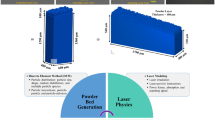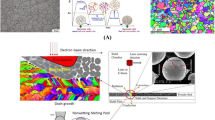Abstract
Cellular metals and metal foams belong to a young material group. Although it is desired to manufacture near-net-shape parts of cellular metals by primary shaping processes, additional secondary machining operations are often unavoidable to obtain the required geometries and quality demands. Nevertheless, conventional machining of cellular metals leads to undesirable surface damage and poor precision. Furthermore, the chip formation and the mechanism description of the surface damage are still unclear. A mesoscopic finite element model was developed to simulate the chip formation process in machining cellular metals. Experimental data of orthogonal machining tests were used to validate the finite element model. The cutting and thrust forces, as well as the images of the chip formation process of both experiments and simulations were compared and analysed. The model enabled the analysis of the chip formation and the surface defect mechanisms. The rake angle and cutting conditions affected the chip formation process, but the cell arrangement was detected as a decisive factor in the chip formation and the resulting surface damage.










Similar content being viewed by others
References
Degischer HP, Kriszt B (2002) Handbook of cellular metals: production, processing, applications. Wiley-VCH, Weinheim
Ashby MF, Evans AG, Fleck NA et al (2000) Metal foams: a design guide. Butterworth-Heinemann, Massachusetts
Bram M, Kempmann C, Laptev A et al (2003) Investigations on the machining of sintered titanium foams utilizing face milling and peripheral grinding. Adv Eng Mater 5:441–447
Weinert K, Bram M, Kempmann C et al (2003) Machinability investigations concerning the milling and grinding of metal foams. Prod Eng 2:65–70
Teicher U, Künanz K, Nestler A (2009) Milling of open-cell metal foams. In: Proceedings of the 6th international conference on porous metals and metallic foams. Bratislava, Slovakia, 1–4 Sept 2009
Ramamurty U, Paul A (2004) Variability in mechanical properties of a metal foam. Acta Mater 52:869–876
Malak SFF, Anderson IA (2005) Orthogonal cutting of polyurethane foam. Int J Mech Sci 47:867–883
Malak SFF, Anderson IA (2008) Orthogonal cutting of cancellous bone with application to the harvesting of bone autograft. Med Eng Phys 30:717–724
Ogata Y, Shirashi J, Nakai T (2000) Various PM parts machinability using cutting tools. In: Proceedings of powder metallurgy world congress 12–16 Nov 2000, 1578–1582
Šalak A, Selecká M, Danninger H (2005) Machinability of powder metallurgy steels. Cambridge International Science Publishing, Cambridge
Denkena B, Tönshoff H (2004) Spanen—Grundlagen. Springer, Berlin
Mackerle J (2002) Finite element analysis and simulation of machining: an addendum: a bibliography (1996–2002). Int J Mach Tool Manuf 43:103–114
Davim J (2011) Machining of metal matrix composites. Springer, London
Banhart J (2001) Manufacture, characterisation and application of cellular metals and metal foams. Prog Mater Sci 46:559–632
Jeon I, Katou K, Sonoda T et al (2009) Cell wall mechanical properties of closed-cell Al foam. Mech Mater 41:60–73
Stephani G, Andersen O, Göhler H et al (2006) Iron based cellular structures—status and prospects. Adv Eng Mater 8:847–852
Kalchunkova N, Guerra R, Teicher U et al (2010) Numerical models of metal foams for the simulation of machining. In: Proceddings of the 8th European conference on foams and applications. Borovets, Bulgaria, 14–16 July 2010
Teicher U, Nestler A (2013) A method to simulate structural properties of cellular materials for machining processes. Procedia CIRP 8:100–104
Hönig A, Stronge W (2002) In-plane dynamic crushing of honeycomb. Part II: application to impact. Int J Mech Sci 44:1697–1714
Kim A, Tunvir K (2006) Study of Al-alloy foam compressive behavior based on instrumented sharp indentation technology. J Mech Sci Technol 20:819–827
Hasan M, Kim A, Lee H (2008) Measuring the cell wall mechanical properties of Al alloy foams using the nanoindentation method. Compos Struct 83:180–188
Caty O, Maire E, Youssef S et al (2008) Modeling the properties of closed-cell cellular materials from tomography images using finite shell elements. Acta Mater 56:5524–5534
Lee WS, Lin CF, Liu TJ (2006) Strain rate dependence of impact properties of sintered 316L stainless steel. J Nucl Mater 359:247–257
Lee WS, Lin CF, Liu TJ (2007) Impact and fracture response of sintered 316L stainless steel subjected to high strain rate loading. Mater Charact 58:363–370
Tounsi N, Vincenti J, Otho A et al (2002) From the basics of orthogonal metal cutting toward the identification of the constitutive equation. Int J Mach Tool Manuf 42:1373–1383
ASM International Handbook Committee (1998) ASM handbook Vol. 7: powder metal technologies and applications. ASM International, Materials Park
Umbrello D, M’Saoubi R, Outeiro JC (2007) The influence of Johnson-Cook material constants on finite element simulation of machining of AISI 316L steel. Int J Mach Tool Manuf 47:462–470
Dassault Systèmes Simulia Corp (2009) ABAQUS User’s manuals, Version 6.9, Providence, Dassault Systèmes Simulia Corp
Fortes M, Colaço R, Vaz F (1999) The contact mechanics of cellular solids. Wear 230:1–10
Guerra R, Teicher U, Nestler A et al (2015) Influence of material and constitutive models on friction analysis for modelling in machining cellular metal structures. Appl Mech Mater 727–728:292–298
Bil H, Kılıç SE, Tekkaya AE (2004) A comparison of orthogonal cutting data from experiments with three different finite element models. Int J Mach Tool Manuf 44:933–944
Acknowledgments
We would like to thank the DAAD-Fundayacucho Scholarship Program and the Center for Information Services and High Performance Computing of the TU Dresden for their support. We would also like to thanks Peter Quadbeck of the Fraunhofer Institute for Manufacturing Technology and Advanced Materials, Branch Lab Dresden for providing the samples of material used in the experiments and Mr. Bernd Nipl for the support during the experiments.
Author information
Authors and Affiliations
Corresponding author
Rights and permissions
About this article
Cite this article
Guerra Silva, R., Teicher, U., Nestler, A. et al. Finite element modeling of chip separation in machining cellular metals. Adv. Manuf. 3, 54–62 (2015). https://doi.org/10.1007/s40436-015-0099-0
Received:
Accepted:
Published:
Issue Date:
DOI: https://doi.org/10.1007/s40436-015-0099-0




